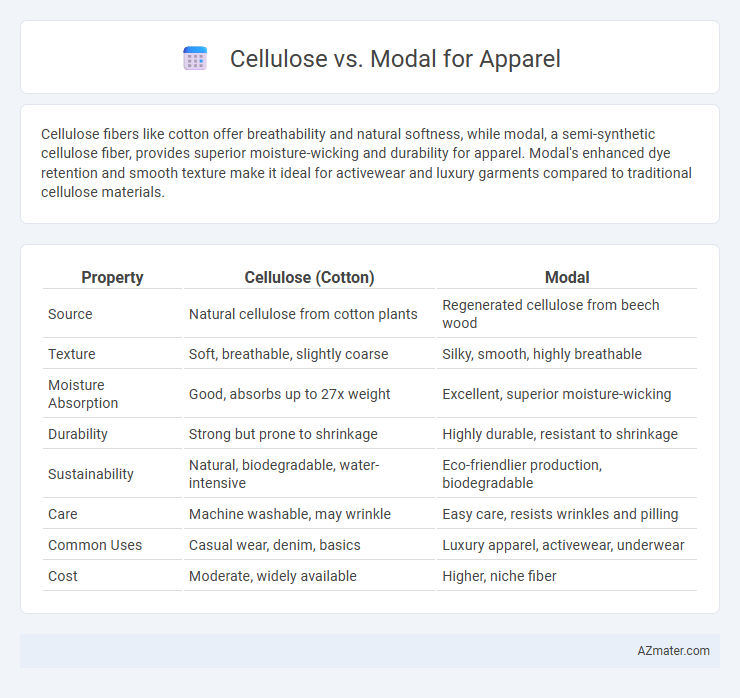Cellulose fibers like cotton offer breathability and natural softness, while modal, a semi-synthetic cellulose fiber, provides superior moisture-wicking and durability for apparel. Modal's enhanced dye retention and smooth texture make it ideal for activewear and luxury garments compared to traditional cellulose materials.
Table of Comparison
| Property | Cellulose (Cotton) | Modal |
|---|---|---|
| Source | Natural cellulose from cotton plants | Regenerated cellulose from beech wood |
| Texture | Soft, breathable, slightly coarse | Silky, smooth, highly breathable |
| Moisture Absorption | Good, absorbs up to 27x weight | Excellent, superior moisture-wicking |
| Durability | Strong but prone to shrinkage | Highly durable, resistant to shrinkage |
| Sustainability | Natural, biodegradable, water-intensive | Eco-friendlier production, biodegradable |
| Care | Machine washable, may wrinkle | Easy care, resists wrinkles and pilling |
| Common Uses | Casual wear, denim, basics | Luxury apparel, activewear, underwear |
| Cost | Moderate, widely available | Higher, niche fiber |
Introduction to Cellulose and Modal Fibers
Cellulose fibers, derived primarily from plant sources like wood pulp and cotton, serve as the foundation for a wide range of sustainable textiles, including modal. Modal is a type of regenerated cellulose fiber made by chemically processing beech tree pulp to create a soft, smooth, and breathable fabric favored in apparel. Compared to traditional cellulose fibers such as cotton or viscose, modal offers enhanced durability, moisture-wicking properties, and resistance to shrinkage, making it a popular choice for high-quality clothing.
Source Materials: Where Cellulose and Modal Come From
Cellulose for apparel primarily originates from wood pulp derived from trees such as eucalyptus, pine, and beech, providing a natural and renewable raw material base. Modal fabric is a type of rayon also made from cellulose, specifically sourced from high-quality beech trees cultivated in sustainable forests. Both materials rely on plant-based cellulose fibers, but Modal undergoes specialized processing to enhance softness, breathability, and durability in textiles.
Manufacturing Processes Compared
Cellulose fibers, derived primarily from wood pulp, undergo a more traditional viscose process involving chemical treatments like carbon disulfide, which results in moderate environmental impact and energy consumption. Modal fibers, a type of high-wet-modulus rayon, utilize a more advanced and eco-friendly manufacturing process featuring closed-loop systems that recycle chemicals and use fewer harmful substances, leading to higher strength and softness in the final apparel. Compared to cellulose viscose, modal production enhances fiber uniformity and durability while reducing water usage and toxic emissions, making it more sustainable for apparel manufacturing.
Environmental Impact: Sustainability and Biodegradability
Cellulose-based fibers such as cotton and linen offer high biodegradability due to their natural plant origin, decomposing efficiently in compost environments with minimal ecological disturbance. Modal, a type of regenerated cellulose made from beech tree pulp, presents a sustainable advantage by utilizing renewable forest resources and employing environmentally friendly closed-loop production processes that recycle water and solvents, significantly reducing pollution. Both fibers contribute to sustainable apparel solutions, but Modal's lower water usage and enhanced strength extend garment longevity, further minimizing environmental impact compared to conventional cotton.
Physical Properties: Strength, Softness, and Durability
Cellulose-based fibers like modal exhibit superior strength and durability compared to standard cellulose fibers such as cotton, making them ideal for long-lasting apparel. Modal fabric is renowned for its exceptional softness and smooth texture, offering a more comfortable wear than traditional cellulose fibers. Enhanced moisture retention and resistance to shrinkage contribute to modal's durability, distinguishing it in physical performance from regular cellulose textiles.
Comfort and Wearability in Apparel
Cellulose fibers, such as those derived from wood pulp, offer natural breathability and moisture-wicking properties that enhance comfort in apparel. Modal, a type of regenerated cellulose fiber, provides superior softness, stretch, and durability compared to conventional cellulose, making it highly wearable for everyday clothing. Both fibers contribute to lightweight, breathable garments, but modal excels in retaining shape and resisting shrinkage, improving long-term comfort and fit.
Moisture Management and Breathability
Cellulose-based fabrics like cotton and modal both excel in moisture management, but modal fibers absorb moisture up to 50% more efficiently, ensuring quicker drying and enhanced comfort. Modal's fine fiber structure offers superior breathability compared to traditional cellulose, promoting better air circulation in apparel. This combination of rapid moisture absorption and breathability makes modal a preferred choice for activewear and high-performance garments.
Care Instructions and Maintenance
Cellulose-based fabrics such as cotton and modal differ significantly in care and maintenance routines; cellulose fibers like cotton require high-temperature washing and ironing, while modal demands gentler care with cold water washing and low-heat drying to preserve fabric softness and prevent shrinkage. Modal fibers exhibit better resistance to fading and pilling, reducing the frequency of garment replacement and extending apparel lifespan through proper handling. Optimal care of modal includes avoiding bleach and fabric softeners, which helps maintain fiber strength and color vibrancy, unlike traditional cotton that tolerates harsher treatment but may lose shape faster.
Cost and Market Availability
Cellulose fibers like viscose are generally more affordable and widely available compared to modal, which is a more refined form of cellulose fiber. Modal offers superior softness and durability, but its production cost is higher, making it less common in mass-market apparel. Market availability of modal is increasing due to growing demand for sustainable fabrics, yet cellulose fibers dominate due to their cost-effectiveness and established supply chains.
Choosing Between Cellulose and Modal for Fashion
Cellulose fibers, derived primarily from wood pulp, provide natural breathability and biodegradability, making them an eco-friendly choice for fashion. Modal, a type of regenerated cellulose fiber, offers enhanced softness, durability, and moisture-wicking properties, ideal for high-performance apparel. Selecting between cellulose and modal hinges on balancing sustainability goals with fabric performance requirements, where modal excels in longevity and comfort while cellulose prioritizes ecological impact.

Infographic: Cellulose vs Modal for Apparel
 azmater.com
azmater.com